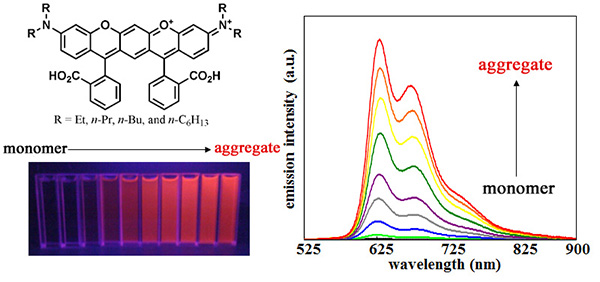Organic fluorescent dye is not used only to add color to materials. Organic fluorescent dyes which have excellent characteristics, such effectively absorbing light and emitting energy, are called "functional dyes", and are used for various, highly advanced technologies such as organic ELs, dye-sensitized solar cells, dye lasers, etc. Organic fluorescent dye emits light when exposed to ultraviolet waves, etc., and is commonly used in the life science field as an indicator when observing molecules and cells in living organisms. When organic fluorescent dye is used in solution or in the solid state, dye molecules aggregate together, significantly reducing functions such as luminous efficiency, chromogenic, photosensitivity, and photosensitizing. This is a major problem hindering improvement and application of dye functionality. As a countermeasure, methods to modify the molecular structure of the dye and to prevent aggregation have been attempted. However, our research group took it as an advantage, and succeeded in developing organic fluorescent dye which enhances light emission when aggregated.
Regarding characteristics of fluorophore, it is empirically known that the molecular structure related to light emission is a conformational planarization. Consequently, it was assumed that if a molecule with an extremely long light emitting part could be created, fluorescence would dramatically increase as the structure distorts until it no longer emits a single ray, and planarity would increase as molecules aggregate (accumulate). Based on this idea, a new organic fluorescent dye named aminobenzopyro-xanthene derivatives (ABPX) was firstly synthesized. One characteristic of ABPX is its aggregation-induced emission enhancement (AIEE) where light emission increases with aggregation. According to this characteristic, it was found that ON and OFF switching of ABPX fluorescence could be controlled by aggregation. ABPX in solution becomes a grain 1/10 to 1/1000 the size of general cell, which emits light. Moreover, fluorescence is in the wavelength range from red, which has a high optical transparency in living organisms, to the near-infrared region. There is the possibility that this light emission may be observed even from outside the body.
By using ABPX which was developed in this time, molecular aggregation in a living organism can be visualized by fluorescence, and can be studied in detail. For instance, it may be possible to clearly identify causes of diseases which are triggered by the aggregation of a protein, such as Alzheimer's and Parkinson's diseases, as well as develop new treatment methods by labeling proteins with ABPX and analyzing their aggregation mechanism. Moreover, in addition to the life science field, ABPX can be applied to various fields such as organic emission devices, medical care, energy and environmental technology, and is expected to become an innovative dye material as a "new concept of applied technology" of organic dye ODF.
*This study was carried out under the joint research of Multiple Molecular Imaging Research Laboratory, RIKEN Center for Molecular Imaging Science (Shuichi Enomoto, Team Leader), and Okayama University Graduate School of Medicine, Dentistry and Pharmaceutical Sciences, Osaka University of Pharmaceutical Sciences, Suzuka University of Medical Science, Hitachi High-Technologies Corporation, and Nara Institute of Science and Technology.
*These study results have been published in
Chemical Communications (2010, Issue 46, Pages 9013-9015), and ranked among the top 10 in November 2010 as most accessed reports in the magazine. And in January 24, 2011, these results were chosen as "study results with innovate ideas" in
Noteworthy Chemistry by the American Chemical Society (ACS).

The chemical structure and emission conditions in the water. When exposed to ultraviolet light (365nm), strong fluorescence is emitted as the monomer turns to aggregate.


